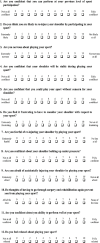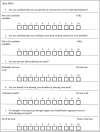Qualitative Research in Return to Sport: a Current Review of the Literature
- PMID: 37480428
- PMCID: PMC10497483
- DOI: 10.1007/s12178-023-09854-y
Qualitative Research in Return to Sport: a Current Review of the Literature
Abstract
Purpose of review: Return to sport (RTS) is an important metric tied to patient satisfaction after receiving treatment for a sports-related injury. Recently, there has been an explosion of literature on RTS; yet a comprehensive review encompassing multiple injuries does not exist. Furthermore, RTS has historically been defined by quantitative measures that assess strength, function, and pain but little consideration has been given to psychologic factors nor has there been an open-ended forum for athletes to share with health care providers which factors they feel are most influential for RTS. This review also serves to heighten surgeons' awareness of underlying psychologic/psychosocial factors affecting RTS.
Recent findings: Qualitative studies which employ open-ended questioning of athletes who have undergone surgical management of superior labral anterior-posterior (SLAP) tears, shoulder instability, ulnar collateral ligament (UCL) rupture, femoral acetabular impingement (FAI), and anterior cruciate ligament (ACL) tear demonstrate that fear of reinjury, lack of social support, and unrealistic expectations are all barriers to RTS. Qualitative studies give health care providers unique insight into the perspectives of their patients so that unmet postoperative needs can be addressed to facilitate RTS. Sports psychologists, coaches, athletic trainers, and physical therapists should create a positive environment to address these needs and provide optimal, holistic care to return athletes to the field safely. Though time consuming, further qualitative research is necessary to understand the unique factors affecting RTS in athletes.
Keywords: Anterior cruciate ligament; Hip arthroscopy; Return to sport; Shoulder instability; Ulnar collateral ligament.
© 2023. The Author(s), under exclusive licence to Springer Science+Business Media, LLC, part of Springer Nature.
Conflict of interest statement
Emily L. DeMaio, MD, Jeffrey D. Tompson, MD, and Vehniah K. Tjong, MD, declare that they have no conflict of interest.
Figures
Similar articles
-
Factors affecting return to sport following hamstrings anterior cruciate ligament reconstruction in non-elite athletes.Eur J Orthop Surg Traumatol. 2019 Dec;29(8):1771-1779. doi: 10.1007/s00590-019-02494-4. Epub 2019 Jul 18. Eur J Orthop Surg Traumatol. 2019. PMID: 31321592
-
Ulnar Collateral Ligament Tear Location May Affect Return-to-Sports Rate but Not Performance Upon Return to Sports After Ulnar Collateral Ligament Reconstruction Surgery in Professional Baseball Players.Am J Sports Med. 2020 Sep;48(11):2608-2612. doi: 10.1177/0363546520947090. Epub 2020 Aug 18. Am J Sports Med. 2020. PMID: 32809845
-
Meeting movement quantity or quality return to sport criteria is associated with reduced second ACL injury rate.J Orthop Res. 2022 Jan;40(1):117-128. doi: 10.1002/jor.25017. Epub 2021 Mar 11. J Orthop Res. 2022. PMID: 33650704
-
One in 5 Athletes Sustain Reinjury Upon Return to High-Risk Sports After ACL Reconstruction: A Systematic Review in 1239 Athletes Younger Than 20 Years.Sports Health. 2020 Nov/Dec;12(6):587-597. doi: 10.1177/1941738120912846. Epub 2020 May 6. Sports Health. 2020. PMID: 32374646 Free PMC article.
-
Return to Sport After Surgical Treatment for Anterior Shoulder Instability: A Systematic Review.Am J Sports Med. 2019 May;47(6):1507-1515. doi: 10.1177/0363546518780934. Epub 2018 Jun 27. Am J Sports Med. 2019. PMID: 29949383
References
Publication types
LinkOut - more resources
Full Text Sources
Research Materials





